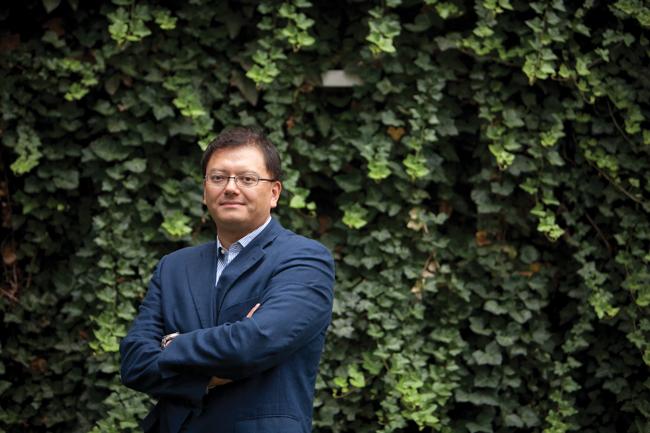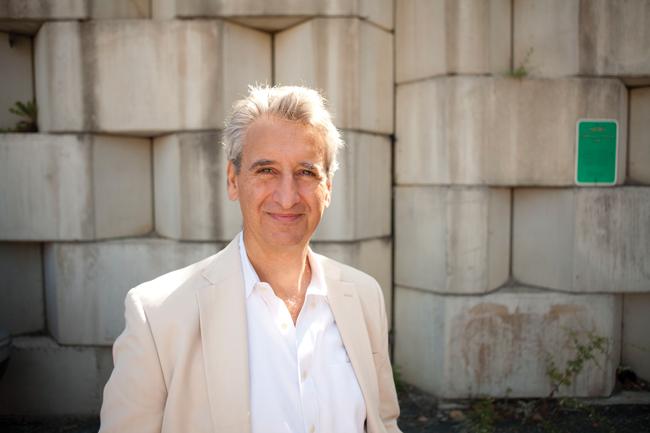A Way with Words
Infants are surrounded by clouds of language that shape their brains and their worlds
- Feature

Gold Saturation with four Q, 2008
Bernar Venet
Acrylic on canvas
200 x 200 cm
The stories of our own beginnings, whether tales of cultural origins or a retelling of a young child’s first words, have an enduring appeal.
Such stories also hold significance. Accounts of a youngster’s first words may become part of the foundation on which a family builds an identity. Twenty years later, a child’s “gank you” rendition of “thank you” has become part of a family’s lexicon, spoken when the parents wish to telegraph a cherished memory. Variants of this story are told every day all over our world, as infants effortlessly acquire one or more languages. But how does this commonplace come to pass? It is this question that researchers are attempting to answer when they investigate not only how infants acquire language, but also how they gain the many complementary skills they will need to live in their world.
A Human Condition
Babies are primed to learn language—any language—while still in the womb, and are born ready to continue the task. Takao Hensch, an HMS professor of neurology at Boston Children’s Hospital, puts it this way, “All infants are born as citizens of the world, meaning that an infant born in Japan could just as easily acquire English as Japanese or any other language.”
The newborn brain is highly plastic; that is, it can readily form new synaptic connections, the types of connections that are vital to processing the continuous streams of new information infants glean from what they hear, see, and touch. Research shows that in the early postnatal period, an infant’s brain forms an abundance of neural connections, and then, over time and in response to environmental influences and experience, pares those connections that are not useful. In language development, this process of perceptual narrowing, says Hensch, allows the brain to rewire itself to better represent its native speech or language. Hensch, whose research focuses on how early life experience physically shapes the brain, adds that “the brain is simply doing what it is good at. It is retaining that which is important and removing that which is not.”

Hensch’s research into critical periods, windows of rich developmental opportunity in early life, has shown in animal models that optimal development requires stimulation while neural connections are maturing. In human infants, for example, this means that if family members talk directly to an infant during the first six months of her life, the baby’s brain will more readily form the strong neural connections necessary for future language development. Without this kind of stimulation, an infant will still learn a language, but on a less-than-ideal foundation.
Critical periods occur when neural activity is tempered, a situation triggered by the action of inhibitory cells. As the brain matures, inhibitory neurotransmitters are released, slowing down the robust synaptic activity of the early postnatal period. In addition, imaging shows that critical periods occur at different times. Says Hensch, “depending on what aspect of language you’re interested in, the activated region will be in a different part of the brain and at a different time in development when things are most plastic.”
An example of how these critical periods manifest can be found in young children as they learn the components of language, says Karin Stromswold ’91, a professor of psychology and cognitive science at Rutgers University. For anyone who has struggled to learn a second language as an adult, the speed with which young children learn language is breathtaking. As Stromswold explains, “there is reason to believe that children are actually already learning language prior to birth. The uterus is not a soundproof booth.”
At birth, babies already know something about the phonology (sound system) of their language and can tell the difference between their mother’s native language and a language that has a different rhythmic pattern. Before age one, most babies understand the meanings of a dozen or so words, and by two years of age, most children can say 200 or more words. Young toddlers also know a surprising amount about the morphology and syntax of their language. Although they often omit words and endings, saying things like “baby spill milk,” and “kitty eating”—and three- and four-year-olds occasionally use the wrong forms of irregular nouns and verbs, saying, for example, “mouses” and “eated”—they nearly always say words in the correct order: They don’t, for instance, say, “milk spill baby” or “eating kitty.” Remarkably, by the time children start kindergarten, the vast majority of what they say is grammatical.
Stromswold’s research on how prenatal and neonatal factors interact with genetic factors to influence linguistic and non-linguistic development suggests that the more formal aspects of language (syntax, morphology, and phonology) may have a stronger genetic component than, for example, vocabulary or discourse and pragmatics (the social aspects of language), each of which is more influenced by the postnatal environment.
Twice as Nice
Babies born into bilingual or multilingual families are as prepared for learning two or more languages as they are for learning one, and research has shown that they can distinguish between two languages before six months of age. The brains of babies who learn sign language accommodate the visual, rather than auditory, inputs of sign by “repurposing” regions of the visual cortex to become language centers.

Neuroimaging has underscored how early learning of more than one language can change the brain. A study in which researchers compared the brain scans of adults who had acquired a second language after age 11 with like scans of adults who had grown up bilingual found activation differences in Broca’s area, a region of the frontal lobe associated with language production. For adults who had grown up bilingual, the neurons in Broca’s area, in response to speech, fired in a diffused pattern. For the adults who had acquired a second language as an adolescent, activation sites were discrete and separable.
Neural activation differences can also be seen in the brains of bilingual adults who code-switch; that is, deftly switch languages in response to social cues. Hensch notes that “bilingual adults use part of the basal ganglia system typically associated with motor control and sequencing patterns and movement—and you can see, on scans, when they code-switch. There is activation in a particular spot when they are switching from one language to another.” This fluency can manifest in bilingual children by or before age three.
Studies in single-language twins reveal other aspects of language acquisition. Nearly all twins are born prematurely and at low birth weights, so, as Stromswold notes, “twins who are developing normally are, on average, two to three months delayed in language development relative to singletons, even when we correct for their prematurity. Twins are also two to three times as likely to be diagnosed with language impairments as singletons.
It has been assumed that twins’ language lag is linked to their hearing less child-directed speech from their parents than single-born children do. Stromswold’s research, however, suggests that much of twins’ language delay results from their being more likely to experience perinatal hardships associated with being born prematurely and at low birth weights.
The Social Variable
Babies may come into the world ready to learn language, but as good as they are at doing this, they cannot accomplish it alone. Whether learning one language or three, babies need to engage with human speech to shape their newly forming neural connections.

According to Claudio Toppelberg, a child and adolescent psychiatric researcher and an HMS assistant professor of psychiatry at the Judge Baker Children’s Center, children in the United States whose first language, or home language, is not English need active support to develop language skills. And U.S. public schools are not currently providing that support. Toppelberg says that his research in the Boston public schools found that dual-language children—the term dual-language is generally favored; the term bilingual suggests equal proficiency in two languages—learn English “at a pace that you almost never see in monolingual children.” He adds that it is incorrect to conclude that young children have “room” for only one language. Although it takes years to master the formal language needed for learning, “there is no evidence that developing a first language undermines the learning of English as a second language.” In fact, he says, even children with learning disabilities can successfully learn two languages.
Toppelberg considers “children’s dual-language ability” a treasure that should be nourished. Current research, in fact, shows that the greater conscription of resources marshaled in learning and simultaneously managing multiple languages may lead to better executive functioning, impulse control, and problem solving.
According to Toppelberg, education in the United States retains a surprisingly tenacious notion that learning two or more languages somehow confuses or is detrimental to children. The problem, he says, is that the beneficial effects of bilingualism may diminish if a dual-language child is denied the support to master both languages.
“Most parents from well-to-do families recognize the benefits of learning two languages,” says Toppelberg. “Why is it then that children from low-income, minority, and immigrant backgrounds are not afforded the opportunity to maintain and develop their own languages?”
Toppelberg studies how language development relates to mental health, particularly in dual-language children in socioeconomically disadvantaged circumstances. His concern is that these children will not only be at a communicative disadvantage, but also, because of that disadvantage, will suffer socially and economically. Bilingual proficiency, in contrast, opens the gates to a range of protective resources, both in a child’s linguistic community and in the larger society, maximizing school engagement and success, and warding off depression, anxiety, and behavioral difficulties.
If allowed to blossom, dual-language children can thrive. Toppelberg, whose family is Spanish/English bilingual, illustrates this point by telling a story of when his son, then 18 months old, was following him around the house babbling in Spanish. As father and son walked outside so Toppelberg could talk with a contractor, the boy spontaneously switched to English, only to swiftly revert to Spanish when they moved back inside. “He did it,” Toppelberg says, “because he knew at some level that he wanted to engage and learn from the contractor. The contractor would not understand him in Spanish. So he switched.”
Susan Karcz is assistant editor of Harvard Medicine magazine.
Images: Archives Bernar Venet, New York; John Soares (Hensch and Toppelberg); Jacob Feldman (Stromswold)